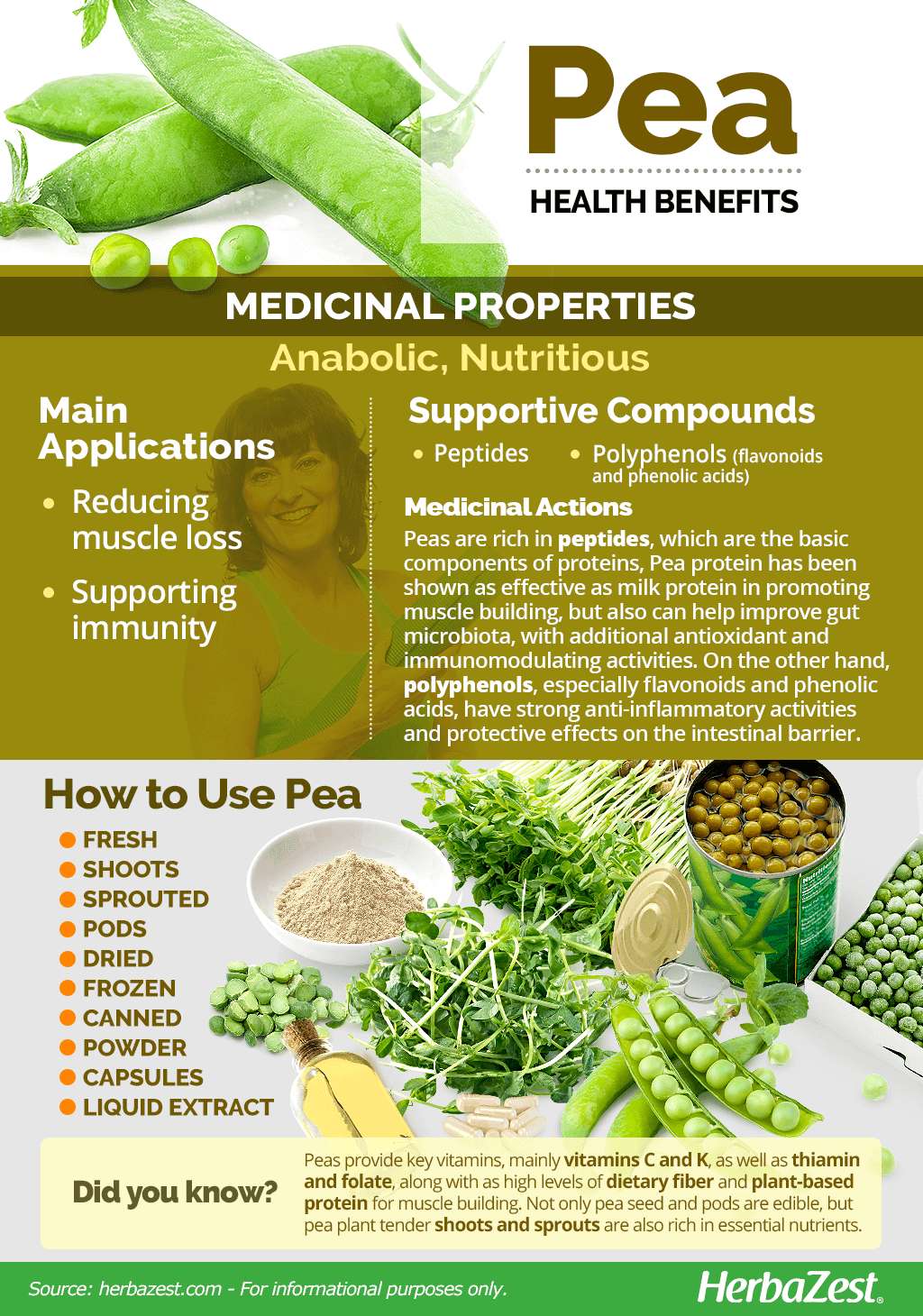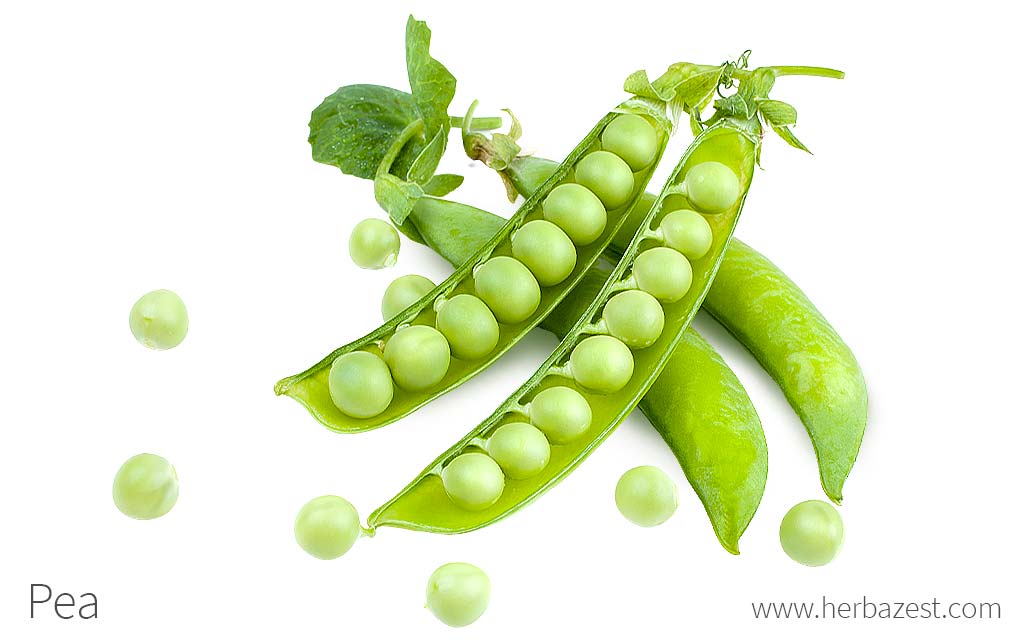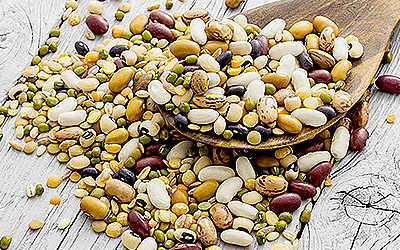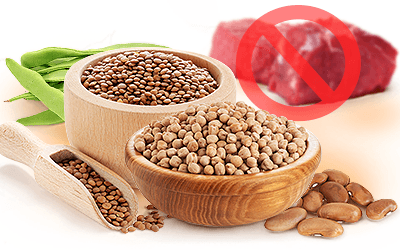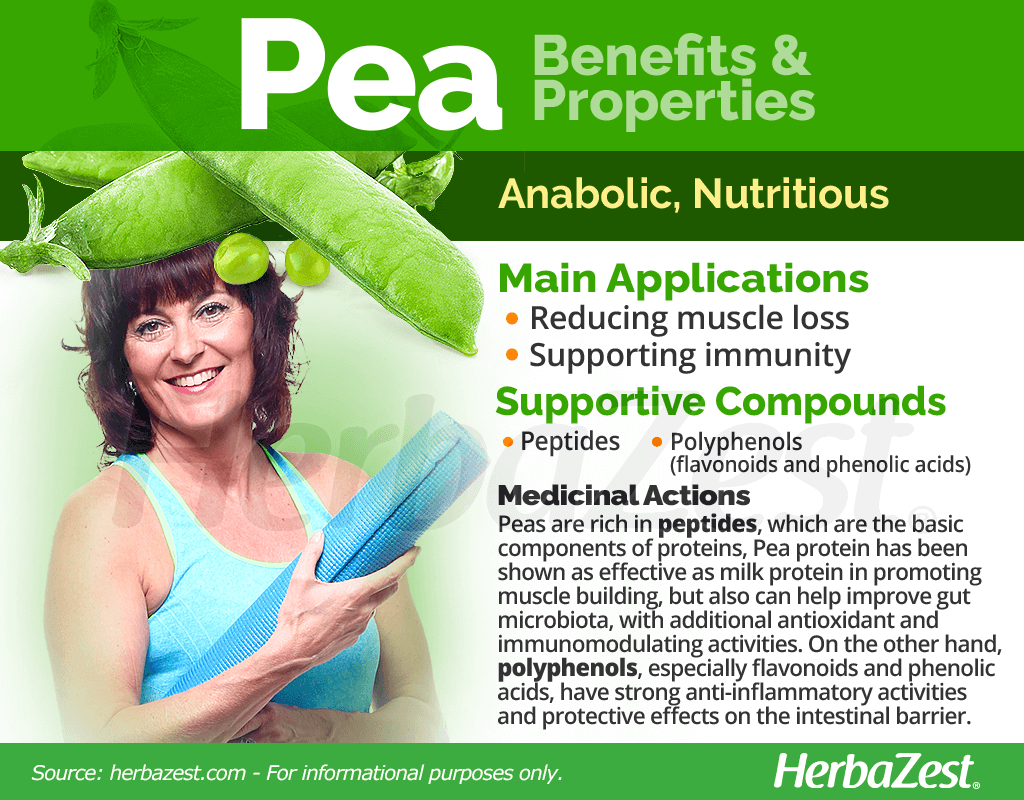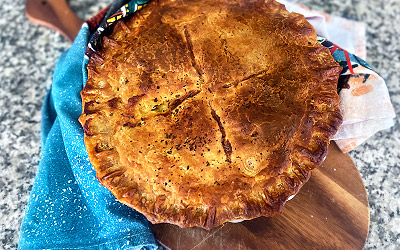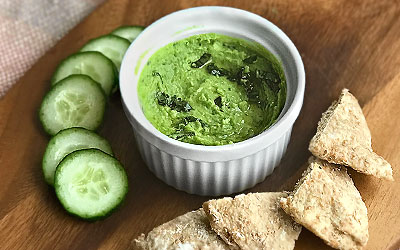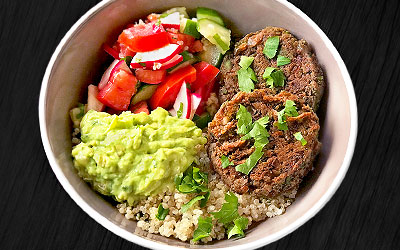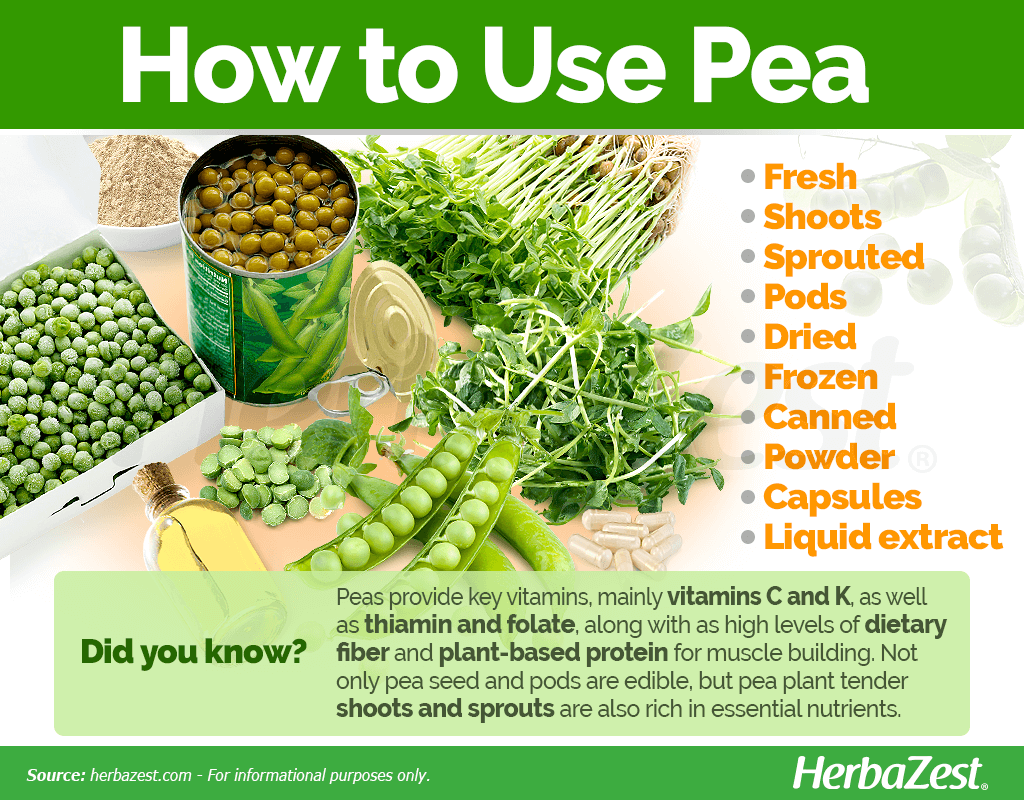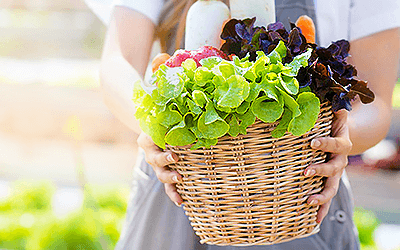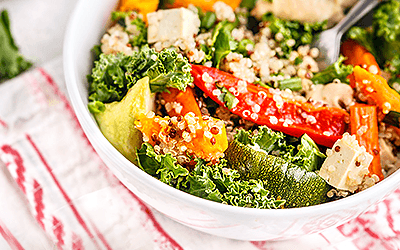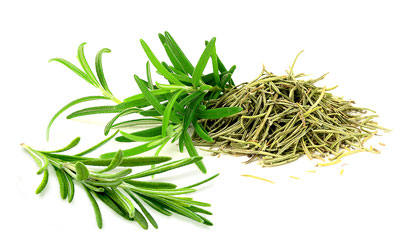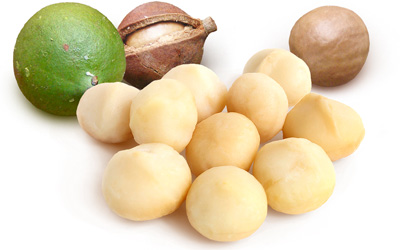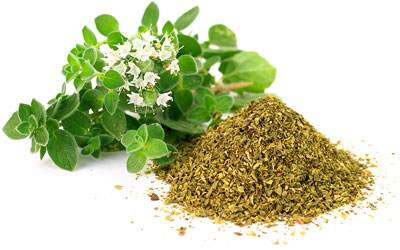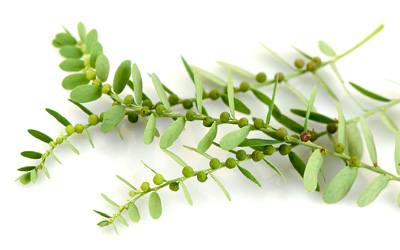Hailing from the Middle East and the Mediterranean basin, peas, also known as common peas, English peas, field peas, green peas, garden peas, sugar snap peas, and snow peas, among other popular names, have been cultivated for millennia. Their impressive nutritional profile makes these vibrant green pearls a functional food with numerous health benefits.
Pea Medicinal Properties
Health Benefits of Pea
Peas are a staple ingredient in kitchens worldwide, valued for its nutritional content. However, scientific research has elevated this legume to the status of a functional food due to its combination of essential nutrients and bioactive compounds. Some of the most significant health benefits of peas include:
Reducing muscle loss. Peas are a particularly rich source of plant-based protein, which supports muscle building and helps prevent age-related muscle mass loss.
Boosting immunity. Peas contain antioxidant and anti-inflammatory compounds that enhance the immune response and may help reduce the risk of chronic and degenerative diseases.
Additional health benefits of peas include:
Improving sugar metabolism. Like other legumes, peas provide a substantial amount of dietary fiber, which slows the absorption of sugar into the bloodstream, aiding glucose control and reducing post-meal sugar spikes.
Promoting digestive health. Peas' dietary fiber supports gastrointestinal health by promoting regular bowel movements and helping prevent constipation and other gut-related issues.
Supporting cardiovascular health. The active compounds of peas help lower harmful cholesterol levels, reducing the risk of atherosclerosis and related conditions.1
Enhancing liver function. Peas may help reduce the accumulation of lipids that lead to liver inflammation and non-alcoholic fatty liver disease, thereby supporting overall hepatic health.2
How It Works
The medicinal properties of peas stem from their macronutrients and bioactive compounds. Peas are rich in bioactive peptides (which are the building blocks of protein), starches, dietary fiber, and non-starch polysaccharides. Pea protein has been found to be as effective as milk protein in promoting muscle building.3 Additionally, it supports gut microbiota and exhibits antioxidant, antimicrobial, antihypertensive, antidiabetic, and immunomodulating activities.4
Studies have shown that regular intake of plant-based protein may increase longevity and improve overall health.
On the other hand, polyphenols, particularly flavonoids and phenolic acids, are abundant in the outer layer of peas. These compounds possess strong anti-inflammatory properties and play a protective role in maintaining a healthy intestinal barrier.5
Other excllent sources of plant-based protein are amaranth, beans, chickpeas, kaniwa, lentils, quinoa, and sacha inchi seeds.
Side Effects & Cautions
Peas are generally safe to consume; however, they contain anti-nutrients such as phytic acid, lectins, and trypsin inhibitors, which can interfere with the absorption of certain vitamins and minerals. As with other legumes, pairing peas with vitamin C-rich vegetables and fruits can enhance the absorption of iron and calcium.
Additionally, some individuals may be sensitive to vicilin, a pea allergen that can trigger adverse reactions.6,7 Symptoms of pea allergy may include asthma exacerbation, gives, difficult breathing, and anaphylaxis.
- Medicinal action Anabolic, Nutritious
- Key constituents Peptides, polyphenols (flavonoids and phenolic acids)
- Ways to use Capsules, Liquid extracts, Food, Powder, Dried
- Medicinal rating (4) Very useful plant
- Safety ranking Safe
Pea Nutrition
Green peas boast a uniquely rich nutritional profile compared to other legumes. These nutrient-dense legumes are excellent source of dietary fiber, high-quality plant-based protein, and essential vitamins and minerals.
The presence of key minerals, mainly copper (for red blood cell production and transport), manganese (for the formation of bones and connective tissue, and sex hormones), and zinc (for metabolic function and immunity), makes peas a great food to incorporate into a balanced diet. Other minerals that peas provide in good or adequate amounts include phosphorus (for tissue and cells regeneration), magnesium (for brain and metabolic health), iron (for red blood cell production and anemia prevention), and potassium (for nerve and muscle function, electrolyte balance, and blood pressure regulation).
Green peas are a powerhouse of vitamins, with astounding levels of vitamin C (ascorbic acid), essential for strengthening immunity, supporting proper iron absorption, and maintaining skin health; vitamin B1 (thiamin) for cellular function and energy production; vitamin B9 (folate) for brain and nerve development; and vitamin K (phylloquinone) for proper blood clotting and bone building. Moreover, peas provide good amounts of other B vitamins, such as B2 (riboflavin), B3 (niacin), and B6 (pyridoxine), as well as adequate levels of choline.
100 grams of raw peas provide 81 calories, 23%DV of dietary fiber, 5%DV of carbohydrates, and 11%DV of plant-based protein.

How to Consume Pea
Peas are nutritious and versatile legumes, with countless applications. They are considered a functional food, providing both nutritional and medicinal properties. The most popular way to reap the benefits of peas is through culinary recipes; however, this friendly legume has also found supplemental uses that support overall health and physical performance.
Natural Forms
Fresh. Fresh peas are ubiquitous across the world. They can be eaten raw, sautéed, steamed, or cooked in a myriad of culinary recipes.
Shoots. Pea shoots are the young leaves and stems of pea plants. These tender parts are highly nutritious and can be consumed raw in salads and sandwiches, as well as lightly sautéed or stir-fried.
Sprouted. Green pea sprouts are the first stage of a pea plant. These newly germinated seeds are a powerhouse of nutrients and bioactive compounds. More popular in Asian countries, they can be consumed in salads and sandwiches.
Pods. Young, tender pea pods containing underdeveloped seeds can be consumed raw, steamed, and stir-fried. They are a common ingredient in many traditional Asian dishes.
Dried. Like other dried legumes, dried split peas must be cooked to unlock their full nutritional and medicinal benefits.
Frozen. Frozen peas are a convenient and healthy option. They provide most of the nutritional value and health benefits of peas, with the added advantage of long-term storage, making them available year-round.
Canned. A practical choice for storage, canned peas are still a good source of fiber, plant-based protein, key vitamins, and antioxidants; however, it's important to choose low-sodium options and be mindful of added sugars in the canning process.
Powder. Due to their high levels of plant-based protein, peas are popular as a nutritional supplement and fitness powder, either alone or mixed with other protein-rich plant sources.
Herbal Remedies & Supplements
Liquid extract. Pea extract has antioxidant properties that are beneficial for the skin, helping to prevent and minimize superficial wrinkles and fine lines.
Capsules. Pea extract, often combined with extracts of other legumes, such as lentils, is also available in convenient capsules that can be taken daily to support general health due to their high antioxidant content.
- Edible parts Seed, Seedpod
- Edible uses Protein
- Taste Sweet, Mild
Growing
Peas, also known as green peas and garden peas, love cold weather and are fairly easy to cultivate in pots, gardens, and backyards. However, in order to thrive, peas require some basic care, including optimal soil conditions, humidity and nutrients.
Growing Guidelines
Pea plants are highly adaptable, but they thrive in well-drained, sandy, silt, or clay loam soils, within a pH range of 5.8 and 7.0.
Peas prefer cool, humid climates, with plenty of direct sunlight, and don't tolerate any shade.
For pea plants to grow optimally, they will need about an inch (2.5 cm) of water per week, in case rain is not sufficient.
Pea plants are easy to grow from seeds, which are sown directly into the soil one inch (2.5 cm) deep and 2 to 3 inches (5-8 cm) apart. They can also be cultivated in containers, which need to have a minimum capacity of two gallons (7.5 liters) and a depth of 12 inches (30 cm).
Pea plants germinate at 40°-85°F (4°-29°C), and they can wilt above that range of temperature. For this reason, timely sowing is essential. For a spring harvest, the seeds must be planted around April, after the last frost, and August can be a good time to sow peas for a fall harvest.
Pea plants are susceptible to some plagues and diseases. They can be attacked by cutworms and aphids, as well as being affected by powdery mildew, root rot and fusarium wilt.
- Life cycle Annual
- Harvested parts Seeds
- Light requirements Full sun
- Soil Well-drained
- Soil pH 5.6 – 6.0 (Moderately acidic), 6.6 – 7.3 (Neutral)
- Growing habitat Cool temperate regions
- USDA Plant Hardiness Zones 3a, 3b, 4a, 4b, 5a, 5b, 6a, 6b, 7a, 7b, 8a, 8b, 9a, 9b, 10a, 10b, 11a, 11b
- Pre-germination seed treatment None, Soaking
- Planting time Fall, Right after last frost
- Plant spacing average 0.5 m (1.64 ft)
- Growing time 60 days
- Potential insect pests Aphids, Cutworms
- Potential diseases Root rot, Powdery mildew
Additional Information
Plant Biology
Pea, also known as the common pea, English pea, garden pea, green pea, field pea, sugar snap pea, and snow pea, among other names, is an annual crop that thrives in cool, temperate climates.
This herbaceous vine can grow up to 3-6 feet (1-2 m), with compound, alternate leaves, oval-shaped and measuring 0.6-2.4 inches (1.5-6 cm) long and 0.4-1.6 inches (1-4 cm) wide. Pea plants climb using the tendrils produced at the base of the leaves. Pea flowers can be white, pink, or purpl, and are borne on the axillary racemes in groups of 1-3 flowers, each reaching 0.6-1.4 inches (1.5-3.5 cm) in length. Pea pods are typically 1.6-5.9 inches (4-15 cm) long and 0.6-1 inches (1.5-2.5 cm) wide, each containing between 2-10 seeds.
Classification
Peas (Pisum sativum) belong to the large Fabaceae, or legume family, which comprises approximately 700 genera and around 17,000 species, including economically important crops such as alfalfa (Medicago sativa), beans (Phaseolus vulgaris), carob (Ceratonia siliqua),
fava beans (Vicia fava), fenugreek (Trigonella foenum-graecum), licorice (Glycyrrhiza glabra), chickpea (Cicer arietinum), lentil (Lens culinaris), lupine (Lupinus spp.), peanut (Arachis hypogaea), soy (Glycine max), tamarind (Tamarindus indica), and winged bean (Psophocarpus tetragonolobus).Varieties & Cultivars of Peas
The genus Pisum contains two species, Pisum fulvum and Pisum sativum. However, two subspecies of P. sativum, ssp. elatius and ssp. humile, are the main genetic base for all existing pea cultivars, with differences in pod and seed size as well as resistance to diseases. Commercially, there are tree main types of peas, classified based on their harvest stage:
Garden or English Peas: Harvested when the seeds are fully grown but still sweet and tender. At this stage, however, pods are not edible.
Snow peas or sugar snap peas: Harvested when the seeds are still underdeveloped and the pods are flat. This type of peas is tender and ideal to be steamed and sautéing. They are popularly used in Asian recipes and are also known as Chinese peas.
Snap peas: Harvested when the seeds have almost reached their maximum development. At this point, pea pods are thick and crunchy. Snap peas may be consumed freshly picked in salads, cooked with the seeds inside their pods, or shelled as garden peas.
The term "pea" can be confusing, as it is sometimes used to refer to species outside the Pisum genus, like yellow pea (Lathyrus aphaca), which produces pea-like fruits often mistaken for peas and used in the same fashion. The same applies to black-eyed peas (Vigna unguiculata), which are actually beans rather than peas.
Historical Information
Peas have been consumed and cultivated by humans since prehistoric times. Evidence suggests that during the last Ice Age, over 11,000 years ago, wild peas were consumed by hunter-gatherers in present-day Europe. Along with other legumes, such as lentils, peas were domesticated very early in human history. Pea seeds dating back to the Bronze Period (3300-1200 BCE) have been found at an archeological site in Syria.
The cultivation of peas has been linked to the dawn of agriculture that led to modern civilization.
In spite of their humble origins, during the Middle Ages, green peas became a favorite among the aristocracy, primarily eaten in cereals and porridge. They did not become widely available to the general population until the 18th century. Hans Christian Andersen's tale The Princess and the Pea (1835) recounts the story of a princess that proves her royal lineage by sensing a pea (most likely a dried pea) under a large pile of mattresses.
Economic data
The largest producer of green peas is China, followed by Russia, India, Canada, and the US. Global pea production is 14.1 million metric tons, covering 18 million acres, with US dry pea production accounting for about 7.1% of total global output.
Other Uses
Cosmetic industry. Due to its anti-aging properties, pea extract promotes skin restoration, regeneration, and elasticity. It is a popular ingredient in skincare products.
Soil restoration. Pea plants have the ability to fix nitrogen in the soil, making them particularly useful as rotational crops to restore soil fertility.
- Other uses Cosmetics
Sources
- Comprehensive Reviews in Food Science and Food Safety, The health benefits, functional properties, modifications, and applications of pea (Pisum sativum L.) protein: Current status, challenges, and perspectives, 2020
- Critical Reviews in Food Science and Nutrition, Composition, physicochemical properties of pea protein and its application in functional foods, 2020
- Field Crops Research, A brief review on the early distribution of pea (Pisum sativum L.) in Europe, 2010
- Food Science & Nutrition, Pea protein isolate characteristics modulate functional properties of pea protein–cranberry polyphenol particles, 2021
- Foods, A Comprehensive Review of Pea (Pisum sativum L.): Chemical Composition, Processing, Health Benefits, and Food Applications, 2023
- Iowa State University, How do the various types of peas differ?
- Journal of Allergy and Clinical Immunology, Is pea our hidden allergen? An American pediatric case series, 2023
- Journal of Food Science and Technology, Anti-fatigue effects of pea (Pisum sativum L.) peptides prepared by compound protease, 2020
- Molecular Nutrition & Food Research, Peptides from Pisum sativum L. enzymatic protein digest with anti-adhesive activity against Helicobacter pylori: structure-activity and inhibitory activity against BabA, SabA, HpaA and a fibronectin-binding adhesin, 2010
- Penn State University, A Gardener's Guide to Peas
- The British Journal of Nutrition, Review of the health benefits of peas (Pisum sativum L.), 2012
- University of California, Agriculture and Natural Resources, Peas for the Privileged, 2020
- University of Connecticut, Peas
- University of Minnesota, Extension - Growing peas in home gardens
- USDA Natural Resources Conservation Service, Pea, Pisum sativum L.
- FAOSTAT, Crops 2020
Footnotes
- Nutrients. (2024). Pea Albumin Extracted from Pea (Pisum sativum L.) Seeds Ameliorates High-Fat-Diet-Induced Non-Alcoholic Fatty Liver Disease by Regulating Lipogenesis and Lipolysis Pathways. Retrieved January 17, 2025, from: https://pmc.ncbi.nlm.nih.gov/articles/PMC11280122/
- Food Science & Nutrition. (2019). Protective effects of mung bean (Vigna radiata L.) and pea (Pisum sativum L.) against high-fat-induced oxidative stress. Retrieved January 17, 2025, from: https://onlinelibrary.wiley.com/doi/full/10.1002/fsn3.1271
- Nutrients. (2021). Pea Proteins Have Anabolic Effects Comparable to Milk Proteins on Whole Body Protein Retention and Muscle Protein Metabolism in Old Rats. Retrieved January 17, 2025, from: https://www.mdpi.com/2072-6643/13/12/4234
- Current Opinion in Food Science. (2022). Recent advances in the health benefits of pea protein (Pisum sativum): bioactive peptides and the interaction with the gut microbiome. Retrieved January 17, 2025, from: https://www.sciencedirect.com/science/article/abs/pii/S2214799322001461
- Journal of Agricultural and Food Chemistry. (2022). Polyphenol Content of Green Pea (Pisum sativum L.) Hull under In Vitro Digestion and Effects of Digestive Products on Anti-inflammatory Activity and Intestinal Barrier in the Caco-2/Raw264.7 Coculture Model. Retrieved January 17, 2025, from: https://pubs.acs.org/doi/10.1021/acs.jafc.2c00102
- Clinical and Experimental Allergy; Journal of the British Society for Allergy and Clinical Immunology. (2020). Pea (Pisum sativum) allergy in children: Pis s 1 is an immunodominant major pea allergen and presents IgE binding sites with potential diagnostic value. Retrieved January 17, 2025, from: https://pubmed.ncbi.nlm.nih.gov/32078204/
- Clinical and Experimental Allergy; Journal of the British Society for Allergy and Clinical Immunology. (2004). Vicilin and convicilin are potential major allergens from pea. Retrieved January 17, 2025, from: https://pubmed.ncbi.nlm.nih.gov/15544600/
